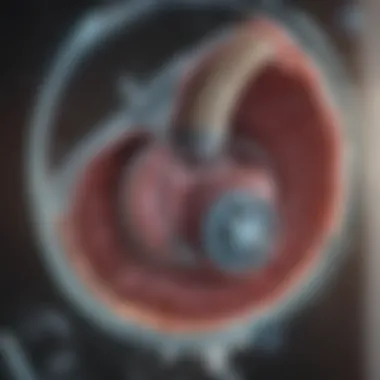Understanding Complications of TAVR Surgery


Intro
Transcatheter Aortic Valve Replacement (TAVR) has transformed the way we approach aortic stenosis, especially for patients who are considered high-risk for traditional open-heart surgery. Yet, while TAVR offers remarkable benefits, it is crucial to recognize the spectrum of complications that can arise. This deep dive will explore the various risks associated with TAVR, arming both patients and healthcare providers with knowledge about potential outcomes and recovery journeys.
Understanding the implications of TAVR goes beyond the procedure itself and enters the realm of patient health, rehabilitation, and even long-term prognosis. By dissecting existing research and clinical data, we aim to paint a clear picture of the consequences – both common and rare – that may surface post-surgery.
Research Overview
Summary of Key Findings
A multitude of studies has focused on TAVR complications, revealing a spectrum of outcomes. Common complications often include issues such as vascular complications, arrhythmias, and bleeding, which can range from minor inconveniences to serious health concerns. Conversely, rare but severe complications like valve malpositioning or infections can have significant ramifications. A consistent theme in the research is that while most patients benefit from TAVR, a subset does experience adverse events that can adversely affect their quality of life.
Methodologies Employed
Research studies related to TAVR complications often employ various methodologies, including:
- Clinical Trials: Randomized trials continue to be the gold standard in assessing the efficacy and safety of TAVR. These trials usually follow patients over time to monitor for complications.
- Meta-Analyses: Aggregating data from multiple studies provides a clearer picture of complications at a larger scale.
- Case Studies: Individual patient cases sometimes delve into unexpected complications, shedding light on unique scenarios that cannot be captured in larger studies.
In-Depth Analysis
Detailed Examination of Results
The results from various studies depict that vascular complications are among the most frequent, often resulting from access site issues during the procedure. These can lead to hematomas or even limb ischemia. In the medium term, patients may experience new-onset atrial fibrillation, which can pose additional risks and may sometimes necessitate further interventions. It’s also important to note that prolonged hospital stays are common for those who face complications, impacting both the patient's physical and mental health.
Comparison with Previous Studies
When comparing these findings with earlier studies, there's a noticeable trend toward improvement. Over time, advancements in device technology and surgical techniques have reduced the incidence of complications. For example, studies from a decade ago reported higher rates of valve-related complications than more recent findings, with newer devices showing enhanced efficacy. However, the research underlines the necessity of ongoing vigilance and comprehensive follow-up for patients post-procedure.
"With careful patient selection and enhanced procedural techniques, the outcomes of TAVR have steadily improved, yet understanding complications remains a priority for clinicians."
These layers of understanding surrounding the complications of TAVR surgery enhance the dialogue between patients and healthcare providers, fostering informed decision-making in considering this life-altering procedure.
Overview of TAVR Surgery
Transcatheter Aortic Valve Replacement, commonly known as TAVR, has become a cornerstone therapy for those suffering from aortic stenosis. This surgery is particularly pivotal for patients considered too high-risk for conventional open-heart surgery. The significance of this topic lies not just in the benefits provided by TAVR but also in understanding the possible complications that may arise, thereby affecting patient outcomes.
The essence of TAVR revolves around its ability to offer relief by replacing a narrowed aortic valve, which can cause significant health issues. Patients often experience symptoms such as chest pain, shortness of breath, and fatigue due to insufficient blood flow. A successful TAVR procedure can dramatically improve these symptoms, leading to a better quality of life.
However, with the advantage of the less invasive approach comes a set of intricacies that should not be overlooked. Understanding the potential complications of TAVR surgery is necessary for both healthcare practitioners and patients alike. This article aims to delve into these complications, exploring various categories, including common risks and serious complications, along with how patient-specific factors can influence outcomes.
"Knowledge is paramount. The more a patient understands about TAVR, including its risks, the more involved they can be in their care decisions."
In the sections to follow, we will unpack the definitions and purpose of TAVR, identify who are the best candidates for this surgery, and ultimately provide a framework to understand the depth of TAVR’s impact on patient health.
Common Complications Following TAVR
The advent of Transcatheter Aortic Valve Replacement (TAVR) has opened new avenues in cardiology, especially for patients with severe aortic stenosis who are not suitable for traditional surgery. However, navigating the waters of medical advances often reveals undercurrents that merit attention. Common complications can surface post-TAVR, impacting patient recovery rates and overall health outcomes. Understanding these complications is not just useful for healthcare providers; it is essential for patients and their families as they consider their treatment options. Awareness of the risks can lead to better preparedness and informed decision-making.
Bleeding Events
Types of bleeding complications
Bleeding complications can take on several forms after TAVR. The most common include:
- Access site bleeding: This often occurs at the puncture site where the catheter was inserted, particularly in the femoral artery.
- Gastrointestinal bleeding: This can arise from anticoagulant usage or other underlying factors post-surgery.
- Intracranial bleeding: Though less frequent, it’s a serious concern, often linked to antiplatelet therapy.
These categories highlight the multifaceted nature of bleeding events associated with TAVR. Understanding their prevalence and mechanisms shines light on why closer monitoring and strategies to mitigate these risks are critical components of post-surgical care.
Management strategies
Management of bleeding events often involves several strategies:
- Compression techniques: For access site bleeding, manual compression or specialized devices are employed to control the bleeding at the puncture site.
- Intravenous fluids and blood transfusions: These may be necessary in cases of significant blood loss or hemodynamic instability.
- Medications: Adjusting or using specific medications to counteract anticoagulation effects can also be a path taken.
These strategies can maximize patient safety but come with their own set of considerations, including potential complications of over-transfusion or insufficient anticoagulation, which necessitate careful assessment.


Infection Risk
Types of infections
Infections pose another potential complication following a TAVR procedure. The most frequently occurring infections include:
- Endocarditis: Infection of the heart valves, necessitating close monitoring for fever or other unusual signs post-surgery.
- Wound infections: Often related to the access site, they can cause complications if not promptly addressed.
The emphasis on these infections underscores the spectrum of risks that can affect recovery trajectories. Understanding how these infections manifest is crucial for timely interventions.
Preventative measures
Preventative measures can make all the difference in managing infection risk:
- Antibiotic prophylaxis: Administering antibiotics prior to the procedure can significantly reduce the risk of endocarditis.
- Post-operative hygiene practices: Maintaining a sterile environment around the surgical site is imperative to minimize wound infections.
While these strategies generally prove effective, they require adherence and team collaboration, as underlying health conditions may influence their success.
Arrhythmias
Mechanisms of arrhythmias
Arrhythmias are another complication worth discussing. They can arise due to various factors:
- Electrolyte imbalances: Post-surgery changes can lead to imbalances that affect heart rhythm.
- Physical trauma: The manipulation of heart structures may disrupt normal electrical pathways.
A clear understanding of how these mechanisms function can aid in preemptive planning and postoperative care.
Treatment options
For arrhythmias, several treatment pathways may be pursued:
- Medications: Antiarrhythmic drugs can help stabilize heart rhythms when necessary.
- Electrophysiological studies: In some cases, further monitoring and analysis may be needed to determine the best course of action.
The variety in treatment options points to the need for personalized approaches, as the effectiveness can vary based on individual patient factors.
Valvular Dysfunction
Causes of valvular dysfunction
Following TAVR, potential causes of valvular dysfunction merit discussion:
- Improper valve sizing: If the new valve does not fit well, it can lead to regurgitation or stenosis.
- Structural changes: The anatomic changes that occur post-surgery can also contribute.
Understanding these causes helps in establishing guidelines for both immediate postoperative monitoring and long-term follow-up.
Long-term implications
The long-term implications of valvular dysfunction can be significant:
- Heart failure: There is potential for progressive heart failure if dysfunction goes unaddressed.
- Need for re-intervention: Some patients may eventually require another surgical intervention if noted dysfunction becomes severe.
These implications underscore the necessity of regular follow-up assessments to catch any developments early on.
In summary, identifying and managing common complications post-TAVR is paramount for optimal patient outcomes, ensuring an informed approach to patient care and recovery in the realm of modern cardiac interventions.
Serious Complications Associated with TAVR
Transcatheter Aortic Valve Replacement (TAVR) has been a game changer in the treatment of aortic stenosis, but it comes with potential serious complications that need to be carefully considered. Understanding these complications is crucial, not only for clinicians but also for patients and caregivers. The complexities surrounding TAVR, especially the serious complications, can significantly inform the decision-making process before undergoing the procedure. Healthcare providers must navigate these risks in order to optimize patient outcomes and lower the rate of adverse events post-surgery.
Stroke
Incidence rates
When discussing stroke associated with TAVR, one of the primary points is that the incidence rates can be perplexing. Research has shown that strokes occur in about 3% to 6% of patients undergoing the procedure, although these rates can vary based on several factors, including patient characteristics and the experience level of the surgical team. The key takeaway here is the necessity for thorough screening and risk stratification prior to surgery; doing so helps in accurately projecting the likelihood of stroke in individual cases.
Certain studies emphasize that the majority of strokes post-TAVR are ischemic, often linked to embolic events during the procedure itself. A unique feature of these incidence rates is that they present a more substantial concern for older patients or those with pre-existing vascular conditions. Understanding this aspect can help healthcare providers to prepare their patients adequately, disclosing the risks in a transparent manner.


Risk factors
The risk factors for stroke following TAVR are numerous and multifaceted. A major one is age—older individuals are naturally at a higher risk due to physiological changes in the vascular system. Additionally, the presence of comorbidities such as atrial fibrillation, hypertension, and diabetes further compounds this risk. Identifying these risk factors is essential for tailoring the clinical approach to each patient.
The unique aspect of risk factors is that they are not fixed; they can be modulated through pre-operative interventions such as optimizing anticoagulation therapy or managing blood pressure effectively. This focus on risk associations serves to empower both patients and clinicians to take proactive steps.
Coronary Obstruction
Identification methods
Coronary obstruction during TAVR can lead to profound complications, making it critical to recognize this risk early on. Identification often employs imaging techniques like intravascular ultrasound and angiography to visualize potential blockages. The challenge, however, lies in the subtlety of signs that may not be instantly obvious.
The importance of identification methods cannot be overstated; timely recognition enhances the chances of averting severe cardiac events. One of the unique elements of these methods is that they may require the integration of advanced technology, which might not be available in all settings. Providers should weigh the benefits against the resource limitations to ensure effective patient monitoring.
Preventative strategies
Preventative strategies are key to mitigating the risk of coronary obstruction. These include pre-procedural assessments and planning, including reviewing the patient's coronary anatomy through imaging studies, as well as utilizing balloon valvuloplasty. It’s essential that the surgical team estimates the position and angle of the new valve installation accurately, as this can significantly affect the risk of obstruction.
One advantage of these preventative strategies is that they not only aim to reduce the risk of obstruction, but also improve overall procedural success rates and patient safety. Engaging in thorough discussions among the multidisciplinary team can yield advantageous outcomes, especially when adapting strategies based on individual patient factors.
Pericardial Effusion and Tamponade
Clinical manifestations
Pericardial effusion is another serious complication associated with TAVR, and its clinical manifestations can range from asymptomatic to severe chest pain and hemodynamic instability. Noticing these changes early is crucial; healthcare workers must be vigilant about symptoms that may indicate fluid accumulation.
What makes the recognition of clinical manifestations particularly important is that they can significantly influence clinical outcomes. A unique aspect of this complication is that it can occasionally present several days after the procedure, adding another layer of complexity to patient management. Knowing when to suspect an issue is essential for timely intervention.
Management approaches
Management approaches for pericardial effusion can vary significantly. A conservative approach might involve monitoring and medical management, whereas individuals showing signs of tamponade might require more invasive interventions such as pericardiocentesis or surgical drainage.
Highlighting the advantages and disadvantages of management techniques presents a nuanced understanding of the challenge. In cases of mild effusions, a watch-and-wait approach can minimize unnecessary procedures. However, when symptoms progress towards tamponade, swift action is paramount to saving the patient’s life.
Mortality Rates
Comparative studies
Mortality rates post-TAVR are a crucial component of its overall risk profile. Comparative studies have shown that while TAVR has improved life expectancy for high-risk patients, it’s vital to understand the context of thought. For example, one study may show a mortality rate of 1% one year after surgery, while another study reports higher figures based on the patient population studied.
The benefit of examining mortality rates through comparative studies lies in uncovering how different cohorts respond to the TAVR procedure, as well as the implications of variations in practice patterns. Each study contributes to a growing narrative about the effectiveness and safety of TAVR.
Factors influencing outcomes
A variety of factors can influence outcomes following TAVR, including baseline characteristics of patients, procedural success, and post-operative care strategies. Age, gender, and the presence of prior heart conditions play roles in how well individuals fare post-surgery.
Emphasizing these factors and understanding their interplay can give healthcare providers insight into improving patient care. Unique to these factors is that they often necessitate personalized treatment plans, reflecting a shift towards individualized medicine. By focusing on these elements, physicians can help to mitigate risks and promote more favorable outcomes in TAVR patients.
Impact of Patient Factors on Complications
Understanding how patient factors influence the complications of TAVR surgery is crucial for tailoring treatment approaches. Each individual presents unique characteristics that can alter clinical outcomes. This exploration sheds light on the interplay between personal health attributes and surgical risks, providing a nuanced perspective essential for healthcare professionals and patients alike.
Age and Comorbidities
Age remains a pivotal component in estimating risk profiles for TAVR candidates. Generally, older individuals—especially those with multiple comorbid conditions—face an elevated likelihood of complications. Conditions like diabetes, obesity, or chronic lung diseases can exacerbate patients' response to the procedure. For instance, an 80-year-old patient with diabetes might experience a higher risk of infection and longer recovery periods compared to a 65-year-old with no underlying health issues.
Furthermore, studies have shown that the presence of comorbidities can lead to an increase in post-operative complications. It’s not just the numbers that count, but the combination of various health factors. Physicians need to consider the cumulative effects of these conditions when determining the appropriate course of action for TAVR patients.
Medical professionals often categorize risk using tools like the Society of Thoracic Surgeons (STS) score to evaluate these factors more systematically.
Sex-based Differences
The impact of biological sex on TAVR outcomes is a significant yet nuanced area of research. Men and women exhibit differing responses to the surgery due in part to variations in anatomy and hormonal influences. Men tend to have a higher incidence of aortic stenosis but women might experience greater procedural risk due to smaller vascular access pathways.
Moreover, studies indicate that women may have better overall survival rates after TAVR compared to their male counterparts, translating into a paradox in risk evaluation. This raises important considerations regarding how healthcare providers discuss risks and benefits with patients. A customized risk-benefit analysis that factors in sex differences is essential for informed decision-making.


Functional Status
Functional status, which encompasses a patient’s physical abilities and overall health, plays a significant role in predicting outcomes after TAVR. Those with higher functional capacity are generally able to tolerate the procedure better and recover more quickly. For example, a patient who actively participates in daily physical activities is likelier to have a favorable outcome compared to someone who is sedentary or frail.
Assessing functional status often involves standardized tools like the Barthel Index or the New York Heart Association classification. These assessments help predict recovery trajectories and potential complications. It’s crucial to use these measurements not only preoperatively but also throughout the recovery period to adjust rehabilitation efforts accordingly.
"The journey post-TAVR doesn’t merely hinge on the surgery itself but also intricately ties back to the patient’s baseline health and activity level.”
In summary, evaluating patient factors such as age, comorbidities, sex-based differences, and functional status provides deep insights into the complexities surrounding TAVR complications. This understanding aids in refining treatment plans to bolster patient outcomes post-surgery.
Long-Term Outcomes Post-TAVR
Understanding long-term outcomes following Transcatheter Aortic Valve Replacement (TAVR) is crucial for evaluating the overall effectiveness and safety of the procedure. TAVR has revolutionized the management of aortic stenosis, primarily for patients at increased risk for open-heart surgery. However, the long-term implications of this intervention are of paramount importance to patients, physicians, and researchers alike.
The focus on long-term outcomes offers insights into several key areas, including patients' quality of life post-procedure, survival rates, and the psychosocial aspects that can arise after such a significant cardiovascular intervention. Each of these areas contributes to an overall understanding of the lasting impact TAVR can have, shaping patient care and clinical practices moving forward.
Quality of Life Assessment
Evaluating the quality of life for TAVR patients is essential. Many studies emphasize that patients typically experience an improvement in their quality of life after the procedure. A considerable number reports lower levels of symptoms associated with aortic stenosis, such as shortness of breathe, fatigue, and chest pain.
However, this assessment isn’t as simple as it may seem. Factors like comorbidities, age, and psychological conditions play vital roles. For instance, older adults may face additional challenges like decreased mobility or cognitive impairments which can hinder perceived well-being.
Several assessment tools, such as the Kansas City Cardiomyopathy Questionnaire or the EuroQoL EQ-5D, are frequently used to gauge these improvements. These data point towards the idea that while many see benefits, others may not experience the same level of enhancement in their quality of life, emphasizing the need for tailored post-operative care.
Survival Rates
Survival rates one year post-TAVR show significantly promising results, often comparing favorably against surgical alternatives. A meta-analysis highlighted that much depends on patients’ baseline health status, with many studies reporting survival rates exceeding 80% at one year.
To add more nuance, factors influencing survival include:
- Age: Elderly patients may experience different outcomes than their younger counterparts.
- Comorbidities: The presence of conditions such as diabetes or kidney disease can adversely affect survival.
- Procedural success: Complications during the procedure can create additional risks.
Understanding these variables gives clinicians insight into patient prognosis after TAVR and helps in making informed decisions about patient management.
Psychosocial Impacts
Besides the physical outcomes, psychosocial impacts are equally critical yet often overlooked. Patients who undergo TAVR may experience various emotional and mental health challenges, including anxiety, depression, or concerns about their future health. These feelings might stem from facing a serious health condition, the surgical experience, or the transitions in their daily lives following the intervention.
Healthcare providers should be cognizant of these factors and provide adequate mental health support. Being proactive in screening for psychological distress can lead to early intervention, improving overall recovery and quality of life. Moreover, social support systems, including family and community connections, can greatly influence a patient’s emotional well-being after the procedure.
"It is crucial to understand that the journey of healing extends beyond physical recuperation in TAVR patients."
Ultimately, integrating an understanding of long-term outcomes related to quality of life, survival, and psychosocial factors leads to improved patient-centered care practices. As TAVR continues to evolve, ongoing research to further explore these outcomes will not only aid clinicians in better supporting their patients but also enhance future models of care.
End: Navigating the Risks of TAVR
When it comes to Transcatheter Aortic Valve Replacement, the stakes are high yet the benefits can be monumental. This section ties together the various threads discussed throughout the article, offering a framework to help both healthcare providers and patients grasp the labyrinth of choices and consequences. Understanding risks becomes essential not only for medical professionals but also for patients preparing to navigate this pivotal decision.
Emphasizing the importance of informed consent is crucial. Patients must clearly understand the potential complications, ranging from common issues like bleeding and infection, to the more serious risks, such as stroke or coronary obstruction. This understanding fosters a collaborative relationship between the patient and the healthcare provider, ensuring that decisions made are rooted in shared knowledge and comprehension of the risks.
Additionally, there's an inherent benefit in looking towards future directions in TAVR research. As medicine continues to advance, ongoing studies can lead to enhanced techniques, improved patient outcomes, and reduced complication rates. This promising outlook helps instill a sense of hope for those awaiting the procedure, as newer methods could provide better safety nets against the risks identified in this article.
In wrapping up, the discussion surrounding complications of TAVR surgery cannot afford to be superficial. Instead, it remains imperative to strike a balance between the value this procedure provides and the risks entailed. Acknowledging these factors not only enhances the quality of care but also empowers patients to make well-informed decisions.
Understanding Informed Consent
Informed consent is more than just a formality; it is the bedrock of ethical medical practice. Before undertaking TAVR, it's vital for patients to engage in thorough conversations with their healthcare providers. The content of these discussions should cover myriad aspects. Patients need to grasp both the short-term and long-term risks associated with TAVR.
A detailed dialogue about possible complications might include:
- Common Complications: Like any surgery, TAVR carries certain risks, including bleeding and arrhythmias. Understanding these helps to set realistic expectations.
- Serious Complications: Providers should also explicate less frequent but severe risks that could arise, like stroke or heart attack.
- Patient's Role: Patients must feel emboldened to ask questions, express concerns, and voice their own health status honestly.
Informed consent should be an ongoing conversation rather than a one-time event. Continuous education about any advancements or shifts in understanding regarding TAVR can significantly shape a patient’s perspective and choices.
Future Directions in TAVR Research
As the landscape of TAVR surgery shifts, ongoing research plays a pivotal role in enhancing safety and efficacy. In recent years, there has been an increase in investigational studies that aim to pinpoint factors influencing complications, thus paving the way for targeted mitigation strategies.
Some of the future developments we can anticipate in TAVR research are:
- Improved Device Designs: Engineers and clinicians are collaborating to refine TAVR valves to minimize complications. AI and digital modeling might be employed to forecast potential issues before the operation even begins.
- Longitudinal Studies: There is a growing need for long-term studies that track patient outcomes beyond initial recovery phases, keeping tabs on how complications might evolve over time.
- Patient-Specific Approaches: Personalized medicine—tailoring interventions to individual characteristics—might revolutionize TAVR applications, enhancing patient selection for better outcomes.
Research not only opens doors to innovations but also cultivates a culture of learning that prioritizes patient safety. By staying ahead of the curve, medical professionals can better navigate the complexities of TAVR surgery, making informed choices that ultimately guide patients towards healthier futures.















